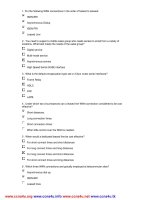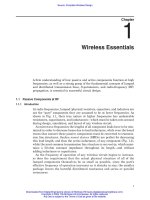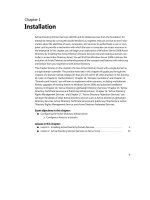Chapter1 a
Bạn đang xem bản rút gọn của tài liệu. Xem và tải ngay bản đầy đủ của tài liệu tại đây (1.11 MB, 30 trang )
Part I: Introduction
Overview:
Chapter goal:
get context, overview, “feel” what’s the Internet
what’s a protocol?
of networking
network edge
more depth, detail later in
network core
course
approach:
access net, physical media
descriptive
performance: loss, delay
use Internet as example protocol layers, service models
backbones, NAPs, ISPs
history
ATM network
1: Introduction
1
What’s the Internet: “nuts and bolts” view
millions of connected computing
devices: hosts, end-systems
pc’s workstations, servers
PDA’s phones, toasters
router
server
mobile
local ISP
running network apps
communication links
workstation
regional ISP
fiber, copper, radio, satellite
routers: forward packets (chunks)
of data thru network
company
network
1: Introduction
2
What’s the Internet: “nuts and bolts” view
protocols: control sending, receiving
of msgs
e.g., TCP, IP, HTTP, FTP, PPP
Internet: “network of networks”
loosely hierarchical
public Internet versus private intranet
Internet standards
router
server
workstation
mobile
local ISP
regional ISP
RFC: Request for comments
IETF: Internet Engineering Task
Force
company
network
1: Introduction
3
What’s the Internet: a service view
communication infrastructure
enables distributed applications:
WWW, email, games, e-commerce,
database., voting,
more?
communication services provided:
connectionless
connection-oriented
cyberspace [Gibson]:
“a consensual hallucination experienced daily by
billions of operators, in every nation, ...."
1: Introduction
4
What’s a protocol?
human protocols:
“what’s the time?”
“I have a question”
introductions
… specific msgs sent
… specific actions taken when
msgs received, or other
events
network protocols:
machines rather than humans
all communication activity in
Internet governed by protocols
protocols define format, order of msgs
sent and received among network
entities, and actions taken on msg
transmission, receipt
1: Introduction
5
What’s a protocol?
a human protocol and a computer network protocol:
Hi
TCP connection
req.
Hi
TCP connection
reply.
Got the
time?
Get />
2:00
<file>
time
Q: Other human protocol?
1: Introduction
6
A closer look at network structure:
network edge: applications and
hosts
network core:
routers
network of networks
access networks, physical
media: communication links
1: Introduction
7
The network edge:
end systems (hosts):
run application programs
e.g., WWW, email
at “edge of network”
client/server model
client host requests, receives service from
server
e.g., WWW client (browser)/ server;
email client/server
peer-peer model:
host interaction symmetric
e.g.: teleconferencing
1: Introduction
8
Network edge: connection-oriented service
Goal: data transfer between end
sys.
handshaking: setup (prepare
for) data transfer ahead of time
Hello, hello back human protocol
set up “state” in two
communicating hosts
TCP - Transmission Control
Protocol
Internet’s connection-oriented
service
TCP service [RFC 793]
reliable, in-order byte-stream data
transfer
loss: acknowledgements and
retransmissions
flow control:
sender won’t overwhelm receiver
congestion control:
senders “slow down sending rate”
when network congested
1: Introduction
9
Network edge: connectionless service
Goal: data transfer between end
systems
same as before!
UDP - User Datagram Protocol
[RFC 768]: Internet’s
connectionless service
unreliable data transfer
no flow control
no congestion control
App’s using TCP:
HTTP (WWW), FTP (file
transfer), Telnet (remote login),
SMTP (email)
App’s using UDP:
streaming media,
teleconferencing, Internet
telephony
1: Introduction
10
The Network Core
mesh of interconnected routers
the fundamental question: how is
data transferred through net?
circuit switching: dedicated
circuit per call: telephone net
packet-switching: data sent
thru net in discrete “chunks”
1: Introduction
11
Network Core: Circuit Switching
End-end resources reserved
for “call”
link bandwidth, switch
capacity
dedicated resources: no
sharing
circuit-like (guaranteed)
performance
call setup required
1: Introduction
12
Network Core: Circuit Switching
network resources (e.g.,
bandwidth) divided into
“pieces”
pieces allocated to calls
resource piece idle if not used by
owning call (no sharing)
dividing link bandwidth into
“pieces”
frequency division
time division
1: Introduction
13
Network Core: Packet Switching
each end-end data stream divided into
packets
user A, B packets share network
resources
each packet uses full link
bandwidth
resources used as needed,
Bandwidth division into “pieces”
Dedicated allocation
Resource reservation
resource contention:
aggregate resource demand can
exceed amount available
congestion: packets queue,
wait for link use
store and forward: packets
move one hop at a time
transmit over link
wait turn at next link
1: Introduction
14
Network Core: Packet Switching
10 Mbs
Ethernet
A
B
C
statistical multiplexing
1.5 Mbs
queue of packets
waiting for output
link
45 Mbs
D
E
Packet-switching versus circuit switching: human restaurant
analogy
other human analogies?
1: Introduction
15
Network Core: Packet Switching
Packet-switching:
store and forward behavior
1: Introduction
16
Packet switching versus circuit switching
Packet switching allows more users to use network!
1 Mbit link
each user:
100Kbps when “active”
active 10% of time
circuit-switching:
10 users
packet switching:
N users
1 Mbps link
with 35 users, probability > 10
active less that .004
1: Introduction
17
Packet switching versus circuit switching
Is packet switching a “slam dunk winner?”
Great for bursty data
resource sharing
no call setup
Excessive congestion: packet delay and loss
protocols needed for reliable data transfer, congestion control
Q: How to provide circuit-like behavior?
bandwidth guarantees needed for audio/video apps
still an unsolved problem (chapter 6)
1: Introduction
18
Packet-switched networks: routing
Goal: move packets among routers from source to destination
we’ll study several path selection algorithms (chapter 4)
datagram network:
destination address determines next hop
routes may change during session
analogy: driving, asking directions
virtual circuit network:
each packet carries tag (virtual circuit ID), tag determines next hop
fixed path determined at call setup time, remains fixed thru call
routers maintain per-call state
1: Introduction
19
Access networks and physical media
Q: How to connection end systems
to edge router?
residential access nets
institutional access networks
(school, company)
mobile access networks
Keep in mind:
bandwidth (bits per second) of
access network?
shared or dedicated?
1: Introduction
20









